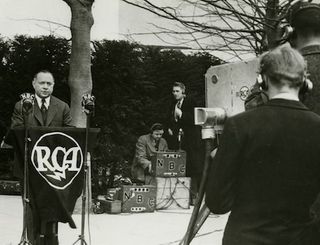B&C at 85: Pointing With Pride

How did it all begin? With a plea from the chairman of the Federal Communications Commission, who “pointed with pride” at broadcasting in the U.S., offering a reminder that while it is the best in the world it has a responsibility to maintain quality apace with evolving technology. Sound familiar?
Perhaps—but this was Oct. 15, 1931, and the “broadcasting” getting all the credit was radio. Back then, there’s a good chance that, with the country knee-deep in the Depression, television in its nascent days and some 55 years after Bell invented the telephone, it would have been a stretch for many to envision a time when you’d be watching broadcasting on your phone. Then again, there’s a chance Broadcasting cofounder Sol Taishoff may have wondered that far ahead, as he declared radio to be “the Fifth Estate” in the editorial of this magazine’s first issue (following the “fourth estate” of print, which monitors the three branches of the federal government).
Much has happened in both the industry and for what is now known as B&C (and, of course, broadcastingcable.com). For 85 years, we have chronicled the unwavering changes, from radio to broadcast television, from broadcast to cable, and to digital streaming. In each case, the new medium was tabbed as “killing” the then-most-popular one. (In a very early issue of Broadcasting, one theater operator complained that radio was killing movies.) The rise of computer technology has lugged this industry through a fascinating series of channel changes, with one important constant being the search for quality in programming.
In the Nov. 26, 1945 issue, the magazine’s name was changed to Broadcasting-Telecasting (still a bargain at 5 cents), with a top story about an FCC increased allocation of TV stations nationwide. World War II was over and television was about to settle into its golden era as first a magnificent one-per-block oddity for the privileged, to soon enough become a commodity, necessity and finally, an assumption. Our 50th anniversary issue, in 1981, not only offered Mr. Taishoff’s remembrances of a half-century of publication and innovation, but featured an outlook of America—and the TV world—in that magical year to come: 2001. That 1981 issue’s prescience can’t be denied, touting “the growing miracles of telecommunications cable and computers,” predicting that “in-home shopping and in-home banking, with scores or hundreds of new channels… will turn many Americans into stay-at-homes, not needing to go out even to work, or cash a check, or buy a newspaper (which, in this case, of course, will have been delivered electronically).” Also, satellite power was forecasted to increase (to coincide with the decrease of dish sizes).
What can’t have been predicted was the ferocious speed of all these changes, along with singular events that shaped the way we’ve watched and the triumphs and tragedies that have forced us all to do so together.
We became Broadcasting & Cable in 1993, with a nod to the obvious. As editor Don West put it then, the magazine “acknowledges parity between these electronic partners. Albeit an uneasy parity.”
Anniversaries are sneaky, ephemeral things. It’s always been popular to wish to live “in extraordinary times,” but compared to the 50th and 75th anniversary issues of this publication, 85 has been more extraordinary, certainly in terms of innovation. Streaming video-on-demand, social media, mobile devices, virtual reality—all have stirred the industry pot since our last milestone. And yet, there are constants. Inside each issue of B&C, even this one, readers can find stories about programmers, advertisers and viewers—the holy trinity that has thrived since the medium began.
Broadcasting & Cable Newsletter
The smarter way to stay on top of broadcasting and cable industry. Sign up below
Rob has written for Broadcasting+Cable since 2006, starting with his work on the magazine’s award-winning 75th-anniversary issue. He was born a few blocks away from Yankee Stadium … so of course he’s published three books on NASCAR, most notably, Full Throttle: The Life and Fast Times of NASCAR Legend Curtis Turner. He’s currently the special projects editor at TV Guide Magazine. His writing has appeared in The Washington Post and his origami art has been in The Wall Street Journal. He lives with his family in New Jersey and is writing a novel about the Wild West.

